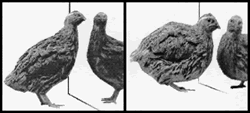
Signals behind motoric expressions: II. Body posture and social proximity in adult birds
S. Mayerhuber and G. Bernroider
Institute of Zoology, University of Salzburg, Salzburg, Austria
Body posture and social proximity in many avian species are well-established measures of emotionally guided behaviour. Here we show how both measures combine in a contextural way depending on previous experience, hormonal status and stimulus situation (Figure 1). In particular, we discuss the sensitivity of both variables to photoperiod dependent gonadal changes in male birds. Further, computer-based feature extraction is used to distinguish the critical features behind body posture within the context of visual stimulation. It is shown how very simple measures of body posture, such as center of gravitiy points for binary masks, can be used for an efficient and sensitive description of emotional responses to conspecifics within one-dimensionally restrained observation designs. Such measures may be extremely useful for standardization, a prerequisite for the development of comparable test paradigms in behavioural research.

Figure 1. Visual access to mirror images causes a spontaneous change in body posture in male quail. This response is not observable in females or gonadally regressed male birds.
Poster presented at Measuring Behavior 2000, 3rd International Conference on Methods and Techniques in Behavioral Research, 15-18 August 2000, Nijmegen, The Netherlands